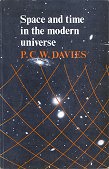
When people think about immortality, they tend to fall into two main groups: those who think about living for a few hundred years, worrying they might get bored; and those who are planning what to do when the last proton decays. In this slim book we discover how even the latter group are being a bit short sighted.
Davies gives us a whistle-stop tour of stellar evolution, the Big Bang (including the inflationary model, where the very early universe is in a excited vacuum state, whose enormous pressure causes a rapid increase in size, followed by collapse to the current true vacuum), black holes, and the difference between second law of thermodynamics entropy and organisational complexity, before getting on to the meat of the book: the End of the Universe. Well, several possible ends, actually, all extrapolations form currently known physics.
If the universe is open, it will go on expanding for ever, getting colder and more diffuse -- Freeman Dyson has shown that life can go on forever, albeit at a slower and slower rate, and moreover needs only a finite, and amazingly modest, amount of energy to do so. On the other hand, if the universe is closed, it will ultimately stop expanding, and contract back to nothing, ending in a Big Crunch. Frank Tipler has shown, surprisingly, that life can also go on "forever" (that is, have infinite subjective experience) in such a universe, by running ever faster as the Big Crunch comes. Davies is a little more skeptical about this extrapolation -- because we know that we don't know the physics at the Crunch.
In either case, even if life doesn't manage to arrange infinite subjective experience, it can certainly last a long time -- for Dyson creatures proton decay will be but a dim and distant memory. Ironically, the inflationary model predicts the universe is very nearly flat, delicately poised between a future of infinite expansion or the Big Crunch -- and that we may have to wait an arbitrarily long time before we find out which.
Davies also touches on some other, more exotic theories: a catastrophic transition to the real vacuum ground state from our current (maybe) false vacuum, and the corresponding "baby universe" models; a cyclic universe model, and why each cycle gets longer; Linde's multiple inflationary bubble model; even the old Steady State model.
In fiction Charles Sheffield gives a good feel for the sheer scale of the universe, and length of time to the big Crunch, in his novel Tomorrow and Tomorrow; Greg Egan has a wonderful description of falling into a black hole in his short story "The Planck Dive"; here we have the fascinating physics behind that kind of fiction.
Overall, Davies paints an optimistic picture of the potentially infinite future, partly in an attempt to counterbalance past authors, from Bertrand Russell to Steven Weinberg, who have been daunted by a vision of a cold, empty, ultimately pointless universe. Davies sees the possibility of a cooling universe, but still full of life and increasing complexity. He does stumble slightly in his last paragraphs, where he asks "Can there be true purpose in a project that is never completed?", and appears to answer this with no. But I think this shows a confusion between an achievable finite goal, and an ongoing infinite purpose. Such a purpose could be that of developing ever increasing complexity, and ever increasing kinds of complexity, ever "onwards and upwards". Chemistry emerges from physics, biology from chemistry, and intelligence from biology. Why think the process stops there? It can be like a class of fractal landscapes with its series of higher and grander peaks, yet with no final summit.
This collection of essays offers the first systematic presentation of what emergence means across the natural and social sciences and in the sphere of religion. Experts lay out the distinctive features of emergence in their respective fields—in quantum physics and astronomy, in cell biology and primatology. Building on this background, leading philosophers of mind then debate the perplexing question of whether, and if so how, consciousness emerges from the functioning of the brain. Again drawing on the results of earlier chapters, theologians and philosophers of religion speculate on how the sphere of religion might be reconceived in light of the emergentist paradigm. Are there significant parallels between instances of emergent complexity in different sorts of natural systems? Is it acceptable to speak of new, emergent forms of casuality? Does emergence further complicate the relation between science and religion, or does it hold a key to overcoming some of the deep tensions between them that have characterized the modern age?
The Re-Emergence of Emergence contains the work both of leading proponents of emergence theory as well as of its most outspoken critics. It provides the clearest presentation yet of this exciting new theory of science—and of its potential pitfalls. It is both an invaluable introduction to the field and a contribution to the ongoing scholarly debate.
In this book, eminent scientists, philosophers, and theologians chart various aspects of information, from quantum, information to biological and digital information, in order to understand how nature works. Beginning with a historical treatment of the topic, the book also examines physical and biological approaches to information, and the philosophical, theological, and ethical implications.